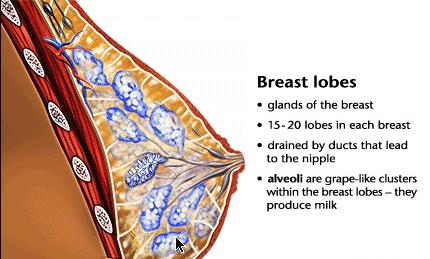A New Mother's Guide to Breastfeeding/How does my body make milk and why is it so special for my baby?
Contents
How does my body make milk and why is it so special for my baby?
The Anatomy of the Breast
The human breast is divided into 15 to 20 lobes, separated from one another by fat and connective tissue, and interspersed with blood vessels, lymphatic vessels, and nerves. These lobes are subdivided into lobules composed of small units called alveoli where milk is synthesized by the alveolar secretary epithelium. The lobules have a system of lactiferous ductules that join larger ducts and eventually open onto the nipple surface. Mothers are often surprised to see milk coming out of multiple nipple pores when they express their milk.
Lactogenesis
| Lactogenesis is defined as "the process of differentiation of cells of the mammary alveoli, as a consequence of which the alveolar cells develop the capacity to secrete milk" or more simply "the production of milk by the mammary glands." |
Milk is produced in small sac-like glands (alveoli) in the breast. These sacs develop after specific hormonal (estrogen, progesterone, pituitary prolactin, and placental lactogen) stimulation that begins at four to six months (second trimester) of pregnancy. The human breast does not store a large volume of milk as most of the milk your baby ingests during breastfeeding is produced during nursing. The two primary hormones that are important for making breast milk are called prolactin and oxytocin. Prolactin is the hormone that makes milk. The more prolactin you have in your body, the more milk you make. Oxytocin is the hormone that helps your milk come out of your breasts. Oxytocin tightens the muscles around the cells in your breasts that make milk so that the milk is squeezed out. This action of squeezing milk out of the breasts is called letdown..
Here is a brief informational video on milk production and the letdown reflex. Click here to view video --> [http://www.youtube.com/watch?v=k1RzlEVkVhg
During a let down, these things may happen:
- Your breasts may tingle.
- The milk may leak or drip from the nipple you are not pumping or using to feed your baby.
- You may feel cramps, or contractions in your uterus, or womb.
- Letdown can happen even when you do not feel or see any of these signs.
Breast Milk
At the beginning of the feeding, the milk is bluish and contains lactose and proteins, but little fat; it is called foremilk. The end of the feeding produces hind milk. The hind milk contains more fat, the main source of energy for your baby. If breast milk is allowed to sit for half-an-hour after being expressed, the "cream" separates and settles on top of the watery part. This is because human milk isn't homogenized. Homogenization is the process that makes the water and fat portion in milk stay in "one layer."
References
Auerbach, K. G. (1990). Breastfeeding fallacies: Their relationship to understanding lactation. Birth, 17(1), 44-49.
Davidson, M., London, M., & Ladewig, P. (2008). Newborn Nutrition. In Maura Conner (Ed.), Olds' maternal-newborn nursing & women's health across the lifespan (8th ed., Rev., pp. 890-927). Upper Saddle River, New Jersey: Pearson Education, Inc.
(2007, August 2). How the body works : Milk let down [Video file]. Retrieved from http://www.youtube.com/watch?v=k1RzlEVkVhg
